Pipe tapping without welding: review of tapping technology
When assembling and connecting water supply or drainage systems, it often becomes necessary to connect pipes, and it is better to do this without the use of a welding machine. However, not all home craftsmen are familiar with the specifics of such delicate work. Do you agree?
We will tell you how to insert into a pipe without welding when laying pipe structures. The article offered for your perusal examines all the methods for making connections for pipes made of various materials. Taking into account our recommendations, you can create a strong, reliably cohesive knot.
The content of the article:
How to connect pipes without welding?
There are several ways to connect pipes to the main line without welding. Some of them are classified as one-piece, which are almost impossible to disassemble without destroying the pipeline. Others are detachable joints that can be easily dismantled and, if necessary, reassembled.
The choice of option depends on what material the pipe is made from.
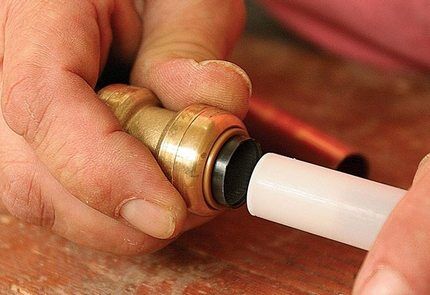
All rolled pipes are divided into two main groups:
- hard - pipes made of cast iron, copper and steel;
- flexible – products are made of polymer materials (polypropylene, metal-plastic, polyethylene).
This separation is based on the need to use a larger engagement area when connecting parts of polymer structures. For comparison: inserting metal pipes can be done in limited conditions, using the minimum engagement area of the parts being joined.
Joining of profile pipes
The most affordable way to connect profile pipes is by installing fastening clamps. Using these simple devices, it is convenient to assemble any type of small-sized metal structures, erecting canopies and shelving, greenhouses and fences, canopies and modular partitions.
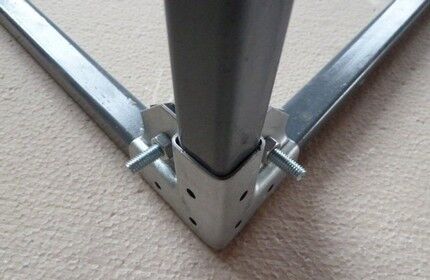
The undeniable advantage of using fasteners is ease of installation and the ability to disassemble the assembled structure an unlimited number of times.
To implement this method you will need only three components:
- Rolled pipes cut to size.
- Required number of fastening clamps.
- Wrench.
Crab clamps can be “X”, “G” and “T”-shaped elements, with the help of which it is convenient to join straight sections of pipes, corner structures and simultaneously connect up to four segments within one unit.
When assembled, they have the shape of a square or rectangle, the sides of which tightly fit the joined parts of the metal pipes.

Fastening with crabs should not cause any particular difficulties. Anyone can insert the cut pipes into the clamp and secure the clamping sticks by tightening the bolts on the system.
But this method can only be used for profile pipes with a cross-section of no more than 20 x 20 mm, 20 x 40 mm and 40 x 40 mm. In addition, joining of elements can only be done at right angles.
You can connect square pipes without welding by installing fittings of a given profile.
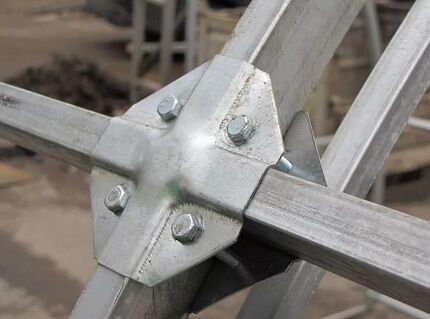
There are several types of fasteners in the form of fittings:
- Couplings - at joints on straight sections.
- Crosses and tees - for installation in branching areas;
- Elbows and turns – if it is necessary to change the direction of the pipeline.
With the help of fittings, you can obtain a fixed fastener, the only vulnerable point of which is the susceptibility to corrosion, which is typical for the ends of the joined elements inserted into it.
This situation occurs as a result of the accumulation of condensate inside the fastener. It will cause rusting if the metal pipes are not treated with an anti-corrosion compound.
Methods for inserting metal pipes
The choice of the optimal tapping method depends on the type of pipes being installed and their operating conditions. The connection can be made at an angle of 90 and 45 degrees, placing them vertically upward or to the side.
Threaded connection option
Non-pressure systems are assembled using a threaded connection, for example, drainage systems made of steel and cast iron or chimneys made of stainless steel.

In most cases, pipe threads are rolled using special equipment. But if desired, this procedure can be performed manually using a cutting tool equipped with teeth - a die. To do this, cut off a workpiece of a given length, making allowance for the threaded part.
The work is performed in the following sequence:
- Pipe sections are strengthened in a bench vise, thereby eliminating the risk of the workpieces twisting.
- To make it easier to fix the die, the outer part of the workpiece is chamfered at an angle of 45°.
- A die is carefully attached to the stripped end of the pipe, being careful to avoid distortion. If this is detected during the first laps, the die must be removed, the workpiece must be tapped, and the procedure must be started over again.
- The baited die is gradually screwed onto the pipe. After several turns, you need to use a level to check the correctness of the cutting.
- Having completed the pipe cutting to the required length, remove the tool by turning it in the opposite direction along the finished thread.
If the tool at some point stops turning, you need to make one revolution in the opposite direction and remove the stuck piece of chips from the thread, then continue working. To simplify the work of creating a threaded connection, it is recommended to lubricate the ends of the workpieces and the cutting tool with machine oil.
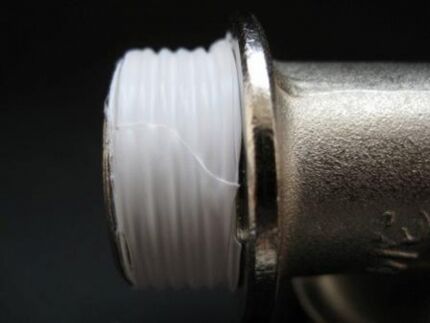
If you have to make cuts in conditions where the pipe is located close to the wall, it is quite difficult to make a full rotation of the tool around the pipe. Using die holders will help make the task easier. They are equipped with ratcheting mechanisms.
Before tightening the threaded connection, it is important to make sure that there are no settled chips or burrs at the ends of the pipes. Tightening the thread should be done with some force.
He will introduce you to the methods of cutting threads on pipes for installing a plumbing system. This article. We recommend that you read this very useful information.
By installing a clamp
This connection method is chosen to create a detachable pipe connection in cases where it is necessary to join elements without welding and without threads. Clamps are flat rings with or without connecting projections, which have holes for studs and bolts.

Assembly sequence for a unit with a flange connection:
- At the site of the intended insertion, a cut of the pipe is made, maintaining a right angle. There is no need to chamfer the end of the pipe; it is enough just to create the most even cutting line possible.
- A clamp is put on the cut that has been cleared of burrs.
- To seal the connection, insert a rubber gasket so that it protrudes 10 mm beyond the cut line.
- The flange is pushed onto the gasket. It is connected to the mating part installed at the end of the second pipe being joined and fixed by screwing the bolts.
When tightening the bolts of the connecting clamps, it is important not to overtighten so as not to damage the fragile elements of the assembly.
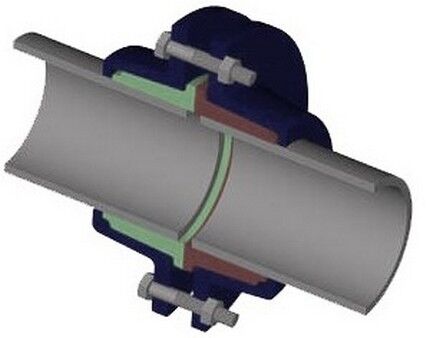
Tightening must be carried out evenly, carefully turning the fastener threads around the entire circumference. It is better to tighten the nuts of the mating parts of the clamp not sequentially, but in pairs. To do this, it is recommended to tighten fasteners diametrically located opposite each other.
Installation of a clamp for connecting a communication line to it is carried out as follows:
By installing couplings
To obtain a hermetic connection of both non-pressure and pressure pipelines, crimp fittings are used. Collets or compression fittings are equipped with ferrules, which are “permanently” pressed during installation.
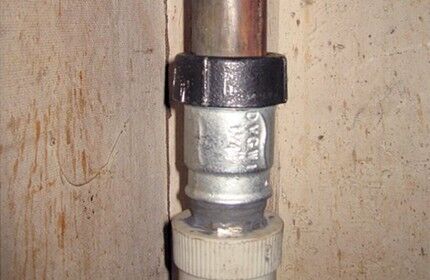
Couplings are conveniently used for connecting pipes of different diameters and made of different types of materials. They are ideal when it is necessary to connect plastic pipes to metal ones.
Tapping into a pipe using a coupling is performed in the following sequence:
- The ends of the pipes to be connected are cut strictly at right angles.
- A coupling is applied to the joint, placing it in such a way that the central part of the device is located strictly along the connection line.
- Marks are made on the pipes to indicate the correct position of the fitting.
- The ends of the pipes and the internal cavity of the coupling are treated with liquid sealant.
- The ends of the first and second pipes are sequentially buried in the coupling. Both workpieces are aligned strictly along the axis.
- When putting on the fitting itself, follow the previously applied markings.
When connecting pipes to external communication lines, couplings with a flange connection type are mainly used:
The connection using the Gebo coupling has also found wide application. This compression fitting is equipped with a compression and sealing ring. The element can be installed without using any special tools.
Working with polymer reinforcement
It is even easier to insert into a polymer pipe. One of the methods does not require complex and most precise cutting of the pipeline. This is especially true when it is necessary to insert plastic elements of large diameters, which can be deformed under the influence of the insertion.
Insertion with pipe installation
To implement this method, you must first purchase a piece of pipe equipped with a pipe from a hardware store. The diameter of the workpiece must correspond to the cross-section of the water supply pipe.

The manufactured blank will create, as it were, a second wall of the pipe. In the workpiece fixed on the pipe, a hole is drilled with a core drill, the diameter of which corresponds to the size of the pipe.
Liquid silicone sealant is applied to the inner surface of the mounted flange. The area around the hole is covered with the same composition, not reaching the cut line by 1 cm. The prepared flange is mounted on the pipe.
To tighten the edges on both sides, two additional fasteners are used. They should be tightened very carefully so as not to squeeze the sealant out from under the flange. The remaining glue that has come out is removed with a napkin.
If you have to make a connection on a plastic pipeline, the system pressure of which is minimal, you can safely use wide construction tape instead of a clamp.
Installation of adapter and saddle
For a sealed and at the same time quick connection of the pipeline, it is convenient to use ready-made elements:
- Adapters – used for inserting pipes D 100-110 mm.
- Saddles - chosen for inserting thin pipes D 32-40 mm.
The saddles are two-part crimp structures that are convenient to install if you need to tap into an unplugged system.
There are modern models of the device on sale, equipped with a heating coil and a cutting cutter with which a hole is made.
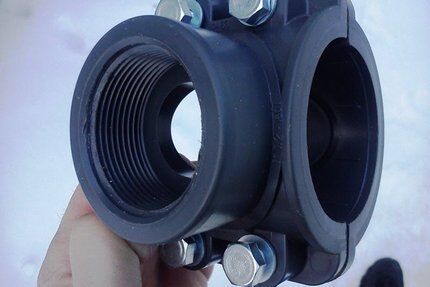
Cutting into a pipe using an adapter is quite simple. The work is carried out in several stages:
- If the pipe is connected to communications, shut off the water in the system.
- Use an electric drill equipped with a crown to make a suitable hole in the desired location.
- Install the adapter onto the prepared area, not forgetting to lay a soft rubber seal.
- Tighten the structure with bolts.
If the design of the embedded element does not provide bolts, construction sealant is used for fixation. To do this, the composition is applied to a degreased surface. The nut is carefully tightened, and any excess product that comes out is removed.
The technology of inserting pipeline branches into a plastic water main is devoted to This article, which we recommend you familiarize yourself with.
Connection of asbestos-cement pipes
Asbestos-cement pipe products, the material for which is Portland cement mixed with asbestos fibers in a ratio of 4:1, are connected by installing couplings and fittings.
The choice of method depends on the operating pressure in the system:
- For pipes with a working pressure within 3 kgf/cc, when inserting, use asbestos-cement double-breasted couplings equipped with rubber seals. Sections 150-200 mm long have a slightly larger diameter than the size of the pipes being connected.
- For pressure pipelines with a working pressure of 3 kgf/cc, special fittings called Gibot couplings are used. They are collapsible structures with flanges and cast iron bushings, complemented by rubber sealing rings.
In both options, rubber sealing rings play a key role in achieving joint tightness.
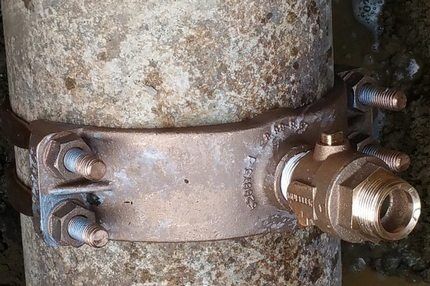
The technology for performing tapping using couplings and fittings is the same as when working with metal fittings. The only thing is that since asbestos-cement products are quite fragile, the insertion should be done with the utmost care.
The intricacies of the process of inserting into an existing water supply system under pressure are described In this article, which we recommend reading. It provides step-by-step guidance on how to make a difficult connection.
Conclusions and useful video on the topic
You can see how you can cut into a pipe without using a welding machine in the following videos.
Tapping into a plastic pipe by installing a coupling:
Insertion option with installation of a ball valve:
There are many connection methods that are a worthy alternative to durable and reliable welding. The main thing is to competently approach the choice of the optimal option and carry out the tie-in, strictly adhering to the technology.
Would you like to share with you personally the intricacies of performing tapping without welding? Do you have questions or photos of the mortise work process? Please write comments and post pictures in the block located under the text of the article.




For my private home, I use pipe connections without welding with detachable joints. Although this leads over time to leaks and seal failure. But this type of connection, in my opinion, has a number of advantages over a non-separable design and connecting pipes by welding. In case of damage, the part can be replaced without dismantling the entire structure. Connecting pipes with detachable joints is simpler in nature than welding. As clearly noted above, there are many ways to reliably connect pipes without welding!